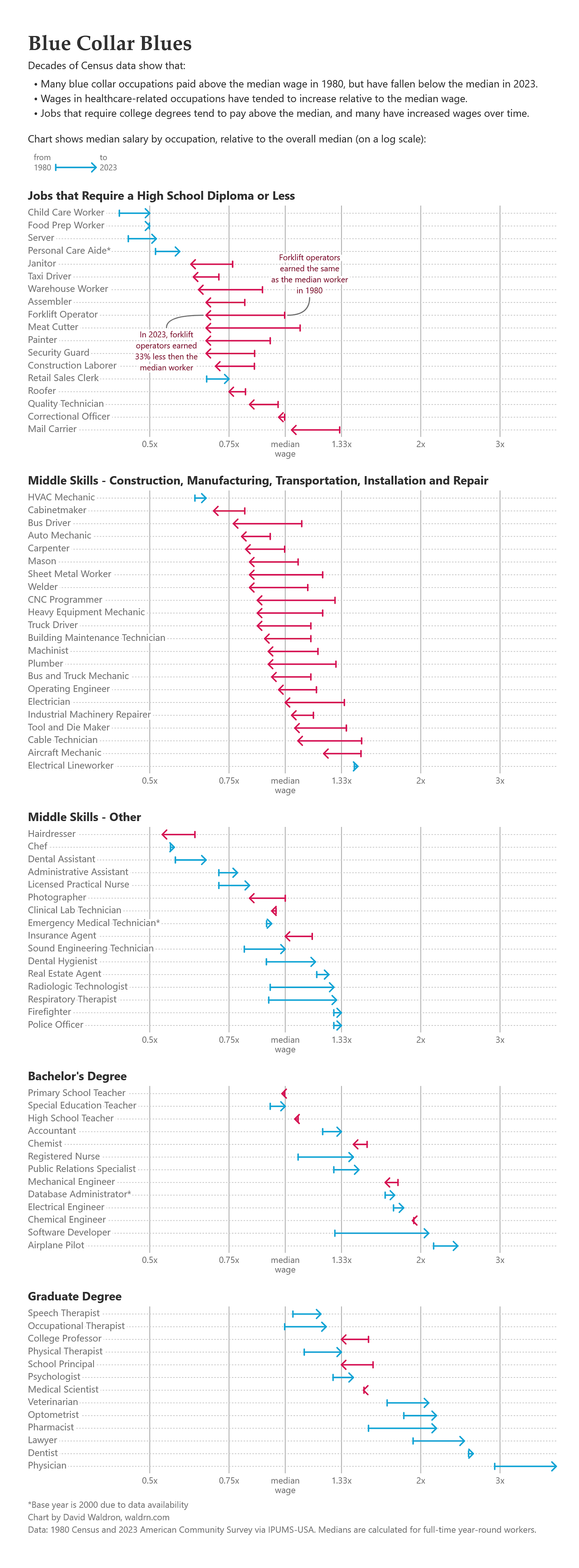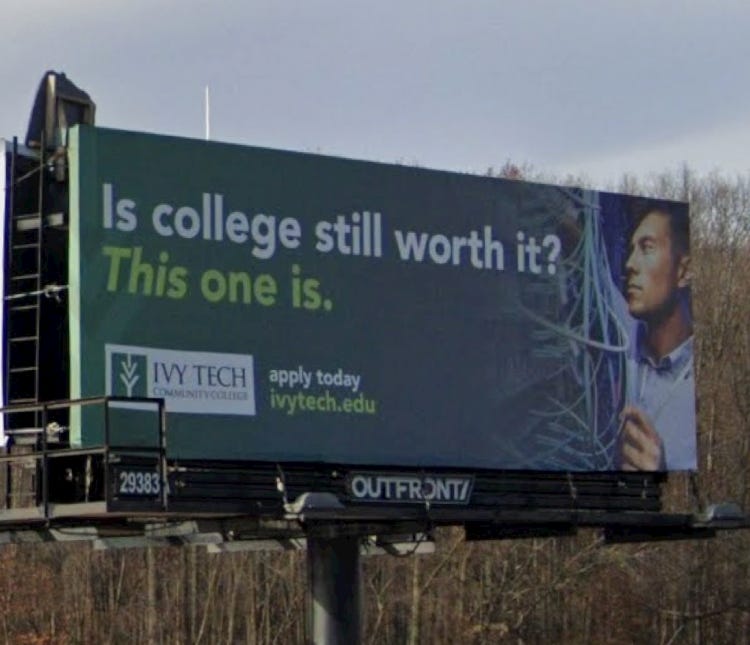The truth about middle-skills jobs
What decades of Census data can tell us about jobs, college and economic opportunity
In 1980, the typical American plumber earned around $56,300 in inflation-adjusted 2023 dollars. This exceeded the overall median wage among full-time, year-round workers by 30%. But between 1980 and 2023, the real median wage for all workers increased from $43,500 to $60,000, and real wages for plumbers remained flat. In 2023, the median plumber earned 8% less than the median worker.
Plumbers aren’t alone. The chart below shows the change in relative wage position for a number of occupations.
The decline in relative wage standing occurred across many blue collar middle-skills occupations, including welders, electricians and CNC programmers. But it has also affected jobs with minimal training requirements, such as forklift drivers, meat cutters and general laborers. In a previous post, I noted the U.S. economy’s shift away from goods-producing industries, and toward services. The declines in relative wages for many occupations reflect that broader structural shift.
Exceptions to the declines in middle-skills wages
Several middle-skills jobs have maintained or improved their relative wage position in the past four decades. Caring occupations that provide healthcare and healthcare support have generally seen increases in their wages relative to the median since 1980. These occupations have strong prospects as the aging population drives continued demand for these services.
Other middle-skills occupations that have performed well include protective services occupations. Police officers and firefighters both earned wages 28% higher than the median wage in 1980, and both have increased their advantage slightly to 33% above the median in 2023.
The value of college
Looking beyond middle skills, it’s evident that jobs that require a college education tend to pay above the median wage, and that many of those jobs have actually seen increased wages relative to the median over the past four decades. To economists, the persistence of the college wage premium is no mystery. Wages reflect the supply and demand for labor, and the demand for college-educated labor has remained strong even as growth in college attainment has slowed. Some people argue that the college wage premium is not causal and reflects selection effects, but the evidence suggests otherwise. College causes substantial financial benefits to the students themselves, to society and even to government budgets.
To the general public, this might be surprising. Skepticism about the value of college has become broadly popular. People focus on rising sticker prices without realizing that expanding financial aid has kept the net cost of college attendance basically flat for many years. “Skip college, learn a trade” has become a popular mantra among adults advising younger generations. Mike Rowe and other commentators routinely disparage college education, while touting an always-approaching shortage of non-college-educated workers. Even advertising by Indiana’s public community college system subtly suggests that 4-year colleges are a bad deal:
Vocational education and training are good. There are many people who will benefit immensely from acquiring additional skills. As we’ve seen above, there are many middle-skills occupations that offer increased economic opportunities, such as in healthcare, policing and firefighting. Even the occupations that have declined in relative standing offer some financial benefits. Welders still earn more than warehouse workers.
But promoting vocational education and training by publicizing falsehoods about the value of 4-year degrees is a mistake. Recent research shows that community colleges provide significant benefits to people who would otherwise have only a high school diploma, but those benefits can be offset by worsened outcomes for people who are diverted from attending 4-year college in favor of 2-year college. Promoting vocational education and training in a way that undercuts attendance at 4-year institutions is misleading and potentially harmful to many people. It also threatens future economic prosperity by putting downward pressure on college attainment rates at a time when the evidence suggests the opposite is needed. Instead, we should understand that there are many middle-skills jobs that pay well and represent economic opportunities for people, while being truthful about which jobs are most likely to provide economic opportunity.
Code for this post is available on GitHub.




Great analysis and visualization, I've never seen this captured so succinctly.
I wonder how much of the relative depression in blue collar wages is caused by illegal immigration increasing the supply of workers. Where I live (California) the trades are almost entirely done by folks of Mexican descent, and statistically quite a few are undocumented.